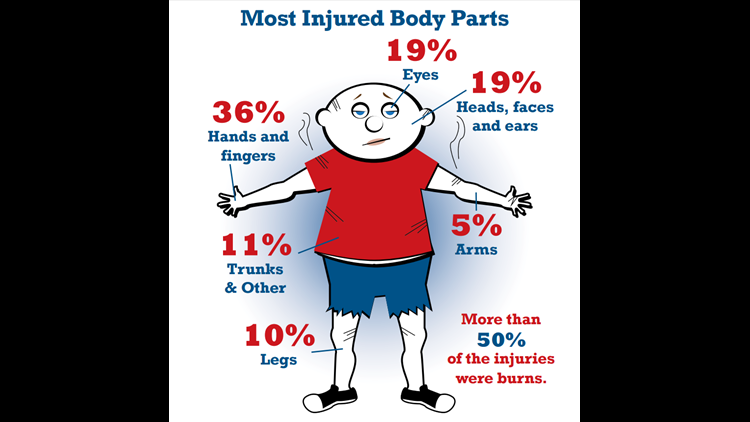

(CNN) — Fireworks are synonymous with Fourth of July celebrations. But as entertaining as sparklers, bottle rockets and other consumer items can be, they’re also responsible for many injuries, which can sometimes result in death.
These injuries, particularly burns requiring hospital stays, are especially high among people 20 and younger, according to new research.
As states have relaxed laws related to fireworks sales over the past decade, emergency doctors saw an increase in both the number and severity of fireworks-related injuries among young people, the data show.
They determined that the number of patients under age 21 treated and released by emergency departments between 2006 and 2012 rose modestly: from 4.28 per 100,000 people in 2006 to 5.12 in 2012. Significantly larger increases were seen in injuries requiring inpatient hospital admission, which skyrocketed (if you’ll pardon the pun) from 29% of cases in 2006 to 50% in 2012.
“Although our findings do not prove a direct link to relaxations in state laws governing fireworks sales, it may be time for lawmakers to reassess this issue,” said Dr. Charles Wood, one of the researchers on the study and associate chairman of pediatrics at the University of Louisville.
Since 2000, there’s been a trend toward relaxing firework restrictions. The latest state to loosen its laws is New York. As of 2015, the state went from an outright ban to legalizing novelty items such as sparklers, party poppers and cone fountains in some counties. Only three states have laws that maintain total prohibition of all consumer fireworks: Delaware, Massachusetts and New Jersey.
“We are currently examining states with strong laws versus weak laws to test for differences. That isn’t leading to significant difference in rates of injury unfortunately,” explained lead study author John Myers, a researcher in the department of pediatrics at the University of Louisville. “However, where we are having luck is examining if rates of injury increase after a law has been relaxed in a given state. We are seeing that by about two years after a law has weakened, the injury rate starts to noticeably increase.”
Data from the American Pyrotechnics Association appear to disagree.
“Fireworks-related injury rates have declined rapidly as the usage of fireworks have increased dramatically,” association Executive Director Julie Heckman said. “The relaxation of the consumer fireworks is improving the injury rate and the fire rate.”
The association’s data are significantly different from Myers’ research for many reasons, he said, perhaps most prominently because of the difference in denominators used for analysis.
The association presents data as injury rate per pounds of fireworks purchased. The data are not stratified by age group, which Myers notes may make it difficult to directly compare with his analysis.
Additionally, the association never explored whether the increase in pounds of fireworks sold is due to individual consumers or city-level purchasers.
“The decrease in the injury rate per pounds of fireworks that they observed may simply be an artifact that city-wide celebrations have increased over time,” Myers said, “artificially leading to a dramatic decrease in the injury rate per pounds of fireworks.”
In contrast, Myers’ research used discharge data from inpatient hospitals and emergency departments.
His findings were presented at the Pediatrics Academic Societies meeting in Baltimore in May. The research has not been published or peer-reviewed.
“In terms of severity of injuries requiring hospital treatment, we are very concerned about the misuse of fireworks and have seen an increase in injuries among youth that have used fireworks in videos unsafely to impress their friends or to get a laugh, and they share these dangerous videos on YouTube,” Heckman said.
To minimize risk of injury, the U.S. Consumer Product Safety Commission recommends never allowing young children to play with or ignite fireworks and to always have an adult supervise fireworks activities.
“Parents don’t realize that young children suffer injuries from sparklers. Sparklers burn at temperatures of about 2,000 degrees — hot enough to melt some metals,” the commission says on its website, which also includes a more comprehensive list of safety tips.



